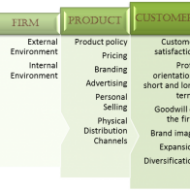Posted by Managementguru in Business Management, Entrepreneurship, Marketing, Principles of Management
on May 15th, 2014 | 0 comments

Market Assessment Framework Industries whether small or large function in an environment of controllable and uncontrollable variables. A small enterprise has to constantly interact with the market in which it has to operate and is also exposed to the risk of other environmental factors. Its marketing efforts must stay fine-tuned to suit the requirements of the market in general and the needs and wants of the customers in particular. They have to develop an exceptional market orientation in light of Intensified industrial activity Increased competition and Increased discerning capacity of customers. Need for Market Assessment: The marketing orientation outlook will drive an entrepreneur to seek answers to many questions relating to market segments, marketing inputs, product quality, price structure, technology of manufacture etc., before setting up the venture. This exercise will facilitate him/her to move ahead with greater degree of confidence and tackle the problems that may arise during the later stages, in a professional manner. Market Composition: Analysis of market demand, the competitive situation and trade practices are vital for a sound market assessment. The market is composed of a large variety of customers who differ in their likes and dislikes, options, preferences, education, employment, income and status. The location of customers also differ, some may be located nearer and others in distant places. Here are 30 Great Marketing Ideas to Increase Sales for Your Small Business: Factors that help a firm to decide the target segment which is of special interest: Resource availability Scale of operation and its Impact on profitability The identification of the customer groups aids in making an estimate of the market demand for the product chosen. Look for Competitive Situation: Once the market demand has been estimated, one has to look for the competitive situation prevailing in the market as a firm cannot just pursue its own policies without considering what the competitors are up to. The nature and extent of competition will place several constraints on the marketing policies of a firm and a thorough analysis of the same will help in pricing and also in identifying the gaps and opportunities that will be available for exploitation. Opportunity Evaluation: An intelligent and experienced entrepreneur would weigh an opportunity as follows: How large is the gap between demand and supply in the market and what is the nature of competition in the market for the product? Whether the product is covered under any of the promotional policies of the government, so that, either entry into business or competition in the market is facilitated. Whether there is any special product/service specific problem that he/she will face and can avail of any part of promotional policies, to soften the impact of these problems. Based on such product-market-policy, policy-product-market type of analysis, the entrepreneur will finally conclude if the opportunity is worth investing...

Posted by Managementguru in Business Management, Marketing, Principles of Management
on Mar 4th, 2014 | 0 comments

Trends in Consumer Marketing FMCG’s: Consumer marketing is defined as creating and selling products, goods and services to individual buyers, as opposed to trying to appeal to businesses. You would have often heard about this – Fast moving consumer goods. These are nothing but products that are destined for use by ultimate customers or households that cannot be done with, as their usage is on a day to day basis. It might make some sense if I cite some examples – toothpaste, soaps, shaving creams, talcs, body lotions; these are meant for personal consumption and the demand for such products is direct and needs less of relationship marketing. Brand Focus: The number of customers in the consumer market is relatively large and the product purchase is influenced by even emotional factors. The focus is on the brand name and some people ardently follow a particular brand for ages, and this might be attributed to the effect that has been created by mass media advertising, or it might be due to the fact that they might identify themselves in some or the other with the product. It becomes a personal companion over a period of time. Impulse Buying: The decision making process is informal and often simple. Sometimes, it is influenced by the budget equations and feasibility. Impulse buying is also common in consumer market. At times, the consumers go adventurous and like to try their hands on new products. Branding is an important feature that retains the customer base for business firms and that’s why market analysts are attaching so much of significance to advertisements and sales promotions, to make their product a household name. Distribution Network: The firms must have a pucca distribution network linking different parts of the territories, where they want to expand their market. Say, for instance, a soft drink can be made popular by branding, but if there is no sufficient supply in the market, how do you expect customers to support your product? Equally important is providing the customers with a product size that best suits their budget. Consumer Marketing Infographic: Researchomatic.com Market Segmentation: Market segmentation recognizes the existence of distinct market groups, each with a distinct set of needs. Through segmentation, the firm directs its product and promotional efforts towards those markets that will benefit most from or will get the greatest enjoyment from its merchandise. Over the years, segmentation has become a popular strategic technique as the market is ever flushed with competitors. Influence of Price: A number of sellers are seen in this kind of consumer market and it is only the market that decides the price and not the participants. The marketers have nothing to lose if they sell at the market price, but if they plan to sell at slightly higher price levels than that of the market, it will prove detrimental to their objective. https://www.businessmodelscholar.com/wp-content/uploads/2020/06/3.pdf They are only price takers and not price makers. But they have the leverage to freely enter and exit the market. If the consumers foresee a fall in the general price levels of a product, they wait for some more time to take full advantage of the situation and decide to postpone the purchase. If the market shows an increasing price trend, it is the other way round, either they buy in bulk or go for substitutes.Say, if the price levels of coffee is on the rise, people opt for tea. Demand for consumer goods is price elastic. Consumers don’t care for much technical specifications; they only care for the quality backed up by a strong brand name. Post by Free MBA...

Posted by Managementguru in Economics, Financial Management, Sales
on Feb 14th, 2014 | 0 comments

Demand and Supply in Different Markets Demand Criteria Since the analysis of a business firm is central to managerial economics, we are primarily interested in the demand for a commodity faced by a firm. The demand for a commodity faced by a firm depends on the size of the market, industry demand for the commodity, the form in which the market is organized and the number of firms in the industry vying for the same set of resources and customers. Demand Curve The market demand curve for a commodity shows the various quantities of the commodity demanded in the market per time period at various alternative prices of the commodity, while holding everything else constant. The curve is negatively sloped, indicating that price and quantity are inversely related. The things held constant in drawing a market demand curve for a product are the number of customers in the market, consumer’s income, the prices of related commodities and tastes. Types of Markets Monopoly and Perfect Competition Coming back to the form of a business firm, at one end there exist the monopolist (the sole producer of a commodity for which there are no good substitutes), and at the other end, perfect competition, where there are a large number of firms producing a homogenous product and each firm is too small to affect the price of the commodity by its own actions. In such a case, each firm is a price taker unlike the monopolist who is a price maker thanks to the product exclusivity factor. Oligopoly In oligopoly there are only a few firms in the industry producing either a homogenous or differentiated product. Since there are only a few firms, the pricing, advertising and other promotional behavior of each firm greatly affect the other firms in the industry and evoke imitation or duplication. We witness many industrial giants fighting for their market share in the respective industrial domains. Monopolistic In monopolistic competition, there are many firms selling a differentiated product. As the name implies, monopolistic competition has elements of both competition and monopoly. The monopoly element arises because each firm’s product is somewhat different from other firm’s products that facilitate the firms to have some degree of control over the price. Although we try to establish an inverse relationship between price and demand, the other side of the coin shows a different picture in that, as the income levels of a consumer is on an increasing trend, his or her purchasing power increases. Consumers tend to purchase more of most commodities like automobiles, housing, travel and so on, when the income rises. There are some goods, however of which the consumer purchases decline as income rises- for example, maize and similar cheap foods as the consumer has the power to buy goods with better quality and there is no need for a compromise. Demand is one of the most important aspects of managerial economics, since a firm would not be established or survive if a sufficient demand for its product did not exist or could not be created. A firm could have the most efficient production techniques and the most effective management, but still without a demand for its product that is sufficient to cover all production and selling costs over the long run, it simply could not survive. Demand is thus essential for the creation, survival and profitability of a...






